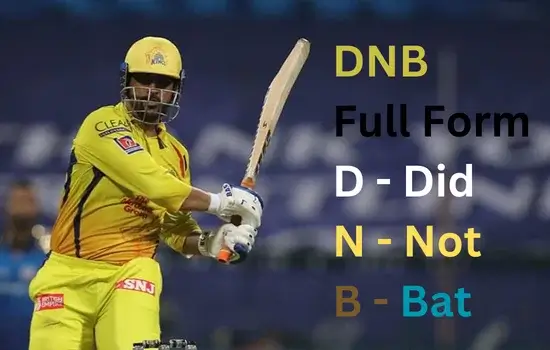In the dynamic world of cricket, where statistics play a pivotal role in evaluating a player’s performance, acronyms and abbreviations abound. One such abbreviation that often appears on the scorecard is DNB, leaving many enthusiasts curious about its meaning. In this exploration, we will demystify the DNB full form in cricket and shed light on its significance in the scoring lexicon.
Full Form of DNB: Did Not Bat
DNB stands for “Did Not Bat,” a notation used in cricket to indicate that a particular batsman did not have the opportunity to bat during the team’s innings. This notation becomes relevant in various situations, each telling a unique story about the dynamics of a cricket match.
Understanding the Context of DNB:
- Top Order Dominance: In scenarios where a team’s top-order batsmen perform exceptionally well, lower-order batsmen might find themselves with the DNB tag. This situation arises when the team’s innings conclude before all the designated batsmen get a chance to showcase their skills.
- Declared Innings: In Test cricket, teams have the option to declare their innings closed, aiming to give their bowlers ample time to dismiss the opposition. In such cases, batsmen who haven’t had an opportunity to bat are marked as DNB.
- Rain-Affected Matches: Weather interruptions, a common occurrence in cricket, can lead to a reduction in the number of overs. This curtailment might result in certain batsmen not getting a chance to bat, warranting the DNB notation.
Significance of DNB in Scorecards:
- Performance Assessment: DNB provides insight into the batting order’s performance. While some batsmen might have faced challenging deliveries and made significant contributions, others may not have had the chance to showcase their skills.
- Team Strategy: The presence of DNB on a scorecard can reflect the team’s strategy. It may signify a swift and dominant batting performance, with the top order efficiently scoring runs and potentially allowing for an earlier declaration.
- Individual Record Keeping: For individual players, DNB impacts their statistical records. Batsmen aim to spend time in the middle, and a DNB entry indicates a missed opportunity to contribute to the team’s score.
Navigating the Full Form of DNB in Cricket: What Does It Mean for Players?
- Mixed Emotions: While being marked as DNB may indicate a team’s batting success, it can evoke mixed emotions for individual players. On one hand, they celebrate the team’s performance, and on the other, there’s a longing for a chance to showcase their batting prowess.
- Adaptability: Cricket demands adaptability, and players understand that the dynamics of the game can limit their time in the middle. Those marked as DNB often channel their energy into other aspects of the game, such as fielding or preparing for their next opportunity.
- Team-First Mentality: Players with the DNB notation embody a team-first mentality. They recognize that cricket is a collective effort, and success is not solely measured by individual batting performances.
Conclusion:
In the cricketing lexicon, DNB, or “Did Not Bat,” represents more than just a statistical notation. It encapsulates the dynamics of a match, the team’s strategy, and individual players’ adaptability. As enthusiasts explore scorecards and statistical records, the DNB full form in cricket serves as a subtle yet significant indicator of the ebb and flow of the game, reminding us that cricket is a sport where each notation tells a unique story.

Hello, I’m Kapil Kumar, a seasoned SEO expert and blogger at WinnersList.in. My mission is to spotlight exceptional individuals and organizations across various domains. Through curated lists, profiles, and inspiring stories, I aim to celebrate outstanding achievements and inspire the next generation of champions. Join me in this journey.




